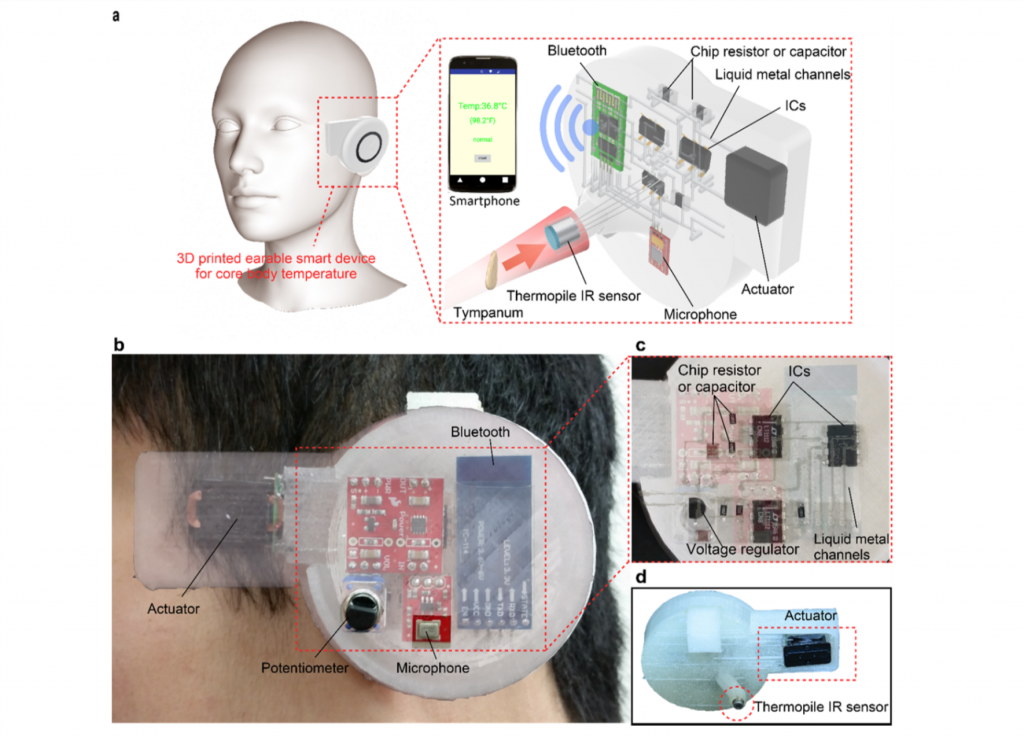University of California at Berkeley’s engineers have created a smart, wearable 3D printed device that is worn on the ear. The project was appropriately nicknamed the ‘earable, and is designed to track core body temperature using an IR sensor.
Two in one – hearing aid and wellness monitor
Though temperature sensors can be found in existing wearable devices such as wristbands, and watches, they only track skin temperature. Therefore they are prone to inaccuracy due to the influence of environmental conditions such as the temperature and humidity.
The earable tracks core temperature – inner temperature- which is the general indicator of whether a person is well or unwell. Therefore it can indicate when a person has a fever, insomnia, fatigue and even depression.

The device also has real time wireless transmission over bluetooth, this means you can connect the earable to your smartphone and monitor your core temperature constantly.
It can also be used as a hearing aid. 3D printing has already disrupted the manufacture of hearing aids. By 2015 the entire U.S hearing aid market was produced using 3D printing. In the same year over 15 million hearing aids were 3D printed. More recently, 3D Printing Industry reported how Swiss hearing solutions technology company Sonova made a titanium hearing aid.
The earable uses the same components as a bone-hearing aid which is useful as it covers up most of ear. This is done through a microphone embedded within the device. The microphone picks up external sounds and transmits them to the inner ear with an actuator in contact with the temple.
How to 3D print a hearing aid
To make the earable, a base substrate with a personalized ear shape and ear canal size is 3D printed with a Maker Gear 3D Printer with Filaflex Filament from Recreus. Filaflex is a stretchable TPE filament. It also contains microchannels for liquid metal interconnects and wells for where integrated circuit chips (IC) can be inserted.
Once 3D printed, a liquid metal alloy called Galinstan is injected into the microchannels instead of the traditional metal wiring.
Then the thermopile sensor, conditioning circuit ICs and bluetooth module are inserted into the microchannel slots as the first device layer. PDMS (silicon-based organic polymer) and epoxy resin are used to set the IC Chips in place. The bluetooth module comprises the first and second of the device’s layers.
After curing, the second layer which houses the bone conduction hearing aid components -the microphone, potentiometer and corresponding conditioning circuits- are inserted into their microchannel pins.The actuator is also placed through the side on the first device layer. Then the second layer is set in place, also using PDMS and epoxy resin. Finally a 3D printed enclosure with holes for the microphone and potentiometer is attached.

Testing the 3D printed device
To ensure functionality several tests were performed. These included frequency analysis of sound conduction at 400,1000,2000 and 5000Hz. The frequency range showed that it was similar to that of a cell phone speaker up to 5000Hz.
An environmental temperature change test involved wearing the earable at various temperatures from 6°C to 40°C. This test verified that skin temperature changed easily in relation to the environment’s conditions whilst the core body temperature remained fairly consistent throughout.
The future of the Earable
In an interview, Ali Javey, a professor of Electrical Engineering and Computer Science, explains “the goal is to work on miniaturizing the device, as well as expanding the range of sensors that are implemented.”
The research paper “3D Printed “Earable” Smart Devices for Real-Time Detection of Core Body Temperature” gives an indication of future applications. For example, monitoring other health signs. The paper concludes,
“While only a bone-conduction hearing aid and tympanic sensor were demonstrated in this work, sensors for measuring other vital signals such as heart rate, pulse oximetry, and EEG may also be integrated into the 3D-Printed Earable device platform for comprehensive long-term, real-time monitoring of an individual’s health and physiological state.”
The paper was written by Hiroki Ota, Minghan Chao, Yuji Gao, Eric Wu, Li-Chia Tai, Kevin Chen, Yasutomo Matsuoka, Kosuke Iwai, Hossain M. Fahad, Wei Gao, Hnin Yin Yin Nyein, Liwei Lin, and Ali Javey.
The full research is available here.
For all the latest 3D printing news, subscribe to the most widely read newsletter in the 3D printing industry, follow us on twitter and like us on Facebook.
Are you researching 3D printing, or looking for scientists to join your team? Sign up to our 3D printing jobs site now.

